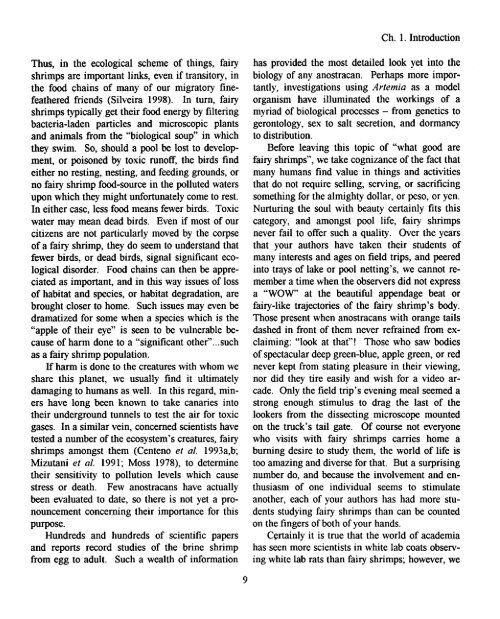Fairy Shrimps
Fairy Shrimps
Fairy Shrimps
Create successful ePaper yourself
Turn your PDF publications into a flip-book with our unique Google optimized e-Paper software.
Ch. 1. Introduction<br />
Thus, in the ecological scheme of things, fairy<br />
shrimps are important links, even if transitory, in<br />
the food chains of many of our migratory finefeathered<br />
friends (Silveira 1998). In turn, fairy<br />
shrimps typically get their food energy by filtering<br />
bacteria-laden particles and microscopic plants<br />
and animals from the "biological soup" in which<br />
they swim. So, should a pool be lost to development,<br />
or poisoned by toxic runoff, the birds find<br />
either no resting, nesting, and feeding grounds, or<br />
no fairy shrimp food-source in the polluted waters<br />
upon which they might unfortunately come to rest.<br />
In either case, less food means fewer birds. Toxic<br />
water may mean dead birds. Even if most of our<br />
citizens are not particularly moved by the corpse<br />
of a fairy shrimp, they do seem to understand that<br />
fewer birds, or dead birds, signal significant ecological<br />
disorder. Food chains can then be appreciated<br />
as important, and in this way issues of loss<br />
of habitat and species, or habitat degradation, are<br />
brought closer to home. Such issues may even be<br />
dramatized for some when a species which is the<br />
"apple of their eye" is seen to be vulnerable because<br />
of harm done to a "significant other"...such<br />
as a fairy shrimp population.<br />
If harm is done to the creatures with whom we<br />
share this planet, we usually find it ultimately<br />
damaging to humans as well. In this regard, miners<br />
have long been known to take canaries into<br />
their underground tunnels to test the air for toxic<br />
gases. In a similar vein, concerned scientists have<br />
tested a number of the ecosystem's creatures, fairy<br />
shrimps amongst them (Centeno et al. 1993a,b;<br />
Mizutani et al. 1991; Moss 1978), to determine<br />
their sensitivity to pollution levels which cause<br />
stress or death. Few anostracans have actually<br />
been evaluated to date, so there is not yet a pronouncement<br />
concerning their importance for this<br />
purpose.<br />
Hundreds and hundreds of scientific papers<br />
and reports record studies of the brine shrimp<br />
from egg to adult. Such a wealth of information<br />
has provided the most detailed look yet into the<br />
biology of any anostracan. Perhaps more importantly,<br />
investigations using Artemia as a model<br />
organism have illuminated the workings of a<br />
myriad of biological processes - from genetics to<br />
gerontology, sex to salt secretion, and dormancy<br />
to distribution.<br />
Before leaving this topic of "what good are<br />
fairy shrimps", we take cognizance of the fact that<br />
many humans find value in things and activities<br />
that do not require selling, serving, or sacrificing<br />
something for the almighty dollar, or peso, or yen.<br />
Nurturing the soul with beauty certainly fits this<br />
category, and amongst pool life, fairy shrimps<br />
never fail to offer such a quality. Over the years<br />
that your authors have taken their students of<br />
many interests and ages on field trips, and peered<br />
into trays of lake or pool netting's, we cannot remember<br />
a time when the observers did not express<br />
a "WOW" at the beautiful appendage beat or<br />
fairy-like trajectories of the fairy shrimp's body.<br />
Those present when anostracans with orange tails<br />
dashed in front of them never refrained from exclaiming:<br />
"look at that"! Those who saw bodies<br />
of spectacular deep green-blue, apple green, or red<br />
never kept from stating pleasure in their viewing,<br />
nor did they tire easily and wish for a video arcade.<br />
Only the field trip's evening meal seemed a<br />
strong enough stimulus to drag the last of the<br />
lookers from the dissecting microscope mounted<br />
on the truck's tail gate. Of course not everyone<br />
who visits with fairy shrimps carries home a<br />
burning desire to study them, the world of life is<br />
too amazing and diverse for that. But a surprising<br />
number do, and because the involvement and enthusiasm<br />
of one individual seems to stimulate<br />
another, each of your authors has had more students<br />
studying fairy shrimps than can be counted<br />
on the fingers of both of your hands.<br />
Certainly it is true that the world of academia<br />
has seen more scientists in white lab coats observing<br />
white lab rats than fairy shrimps; however, we<br />
9
















